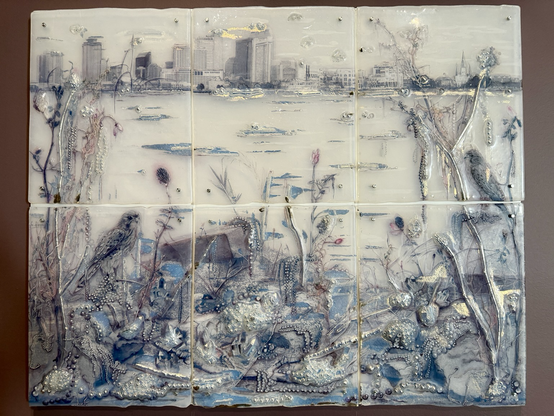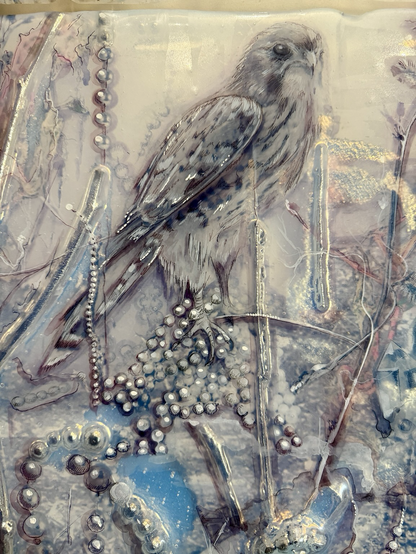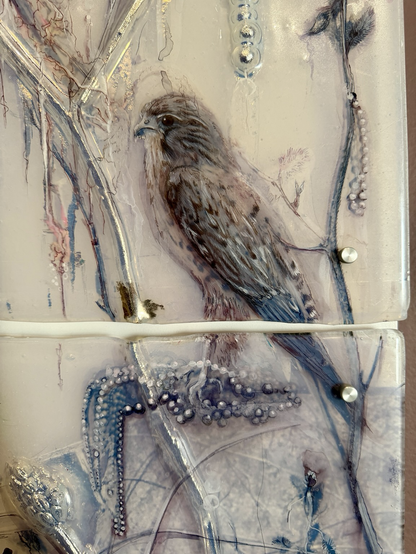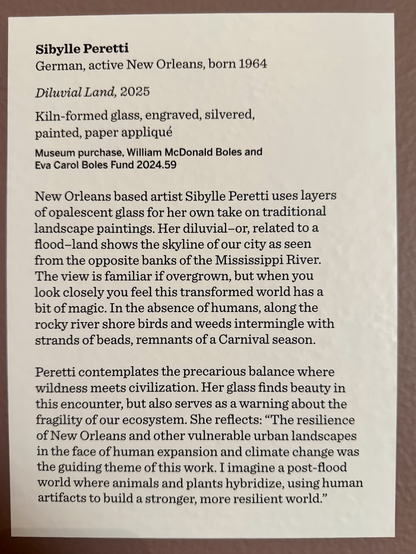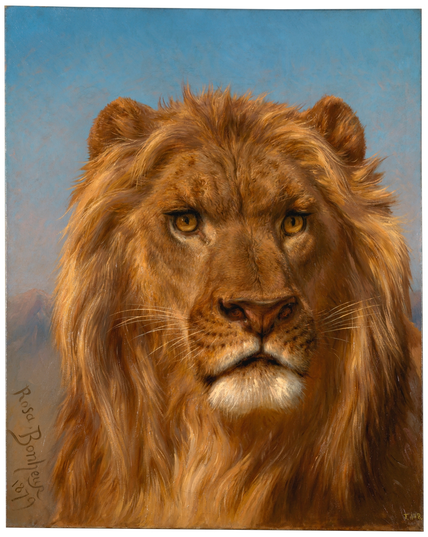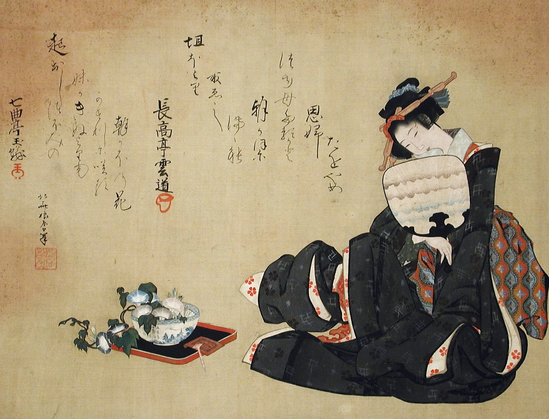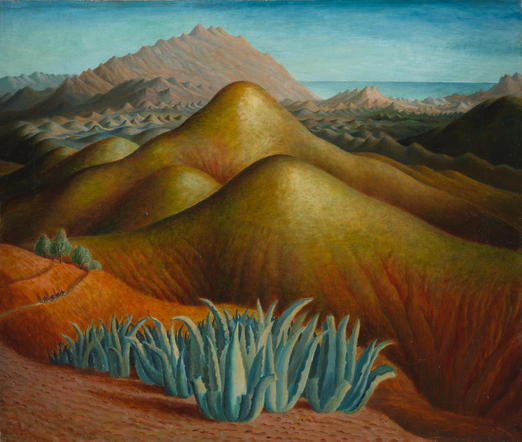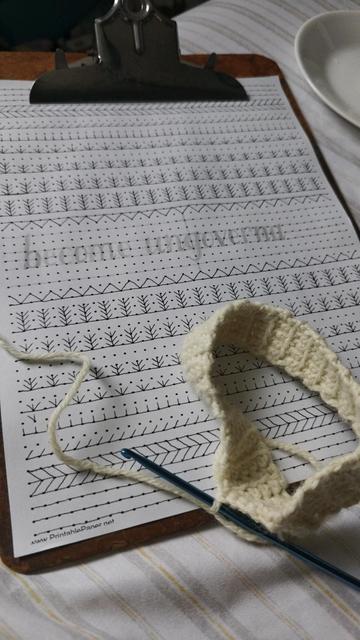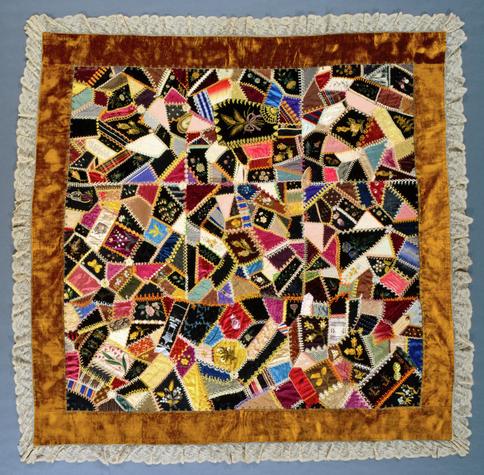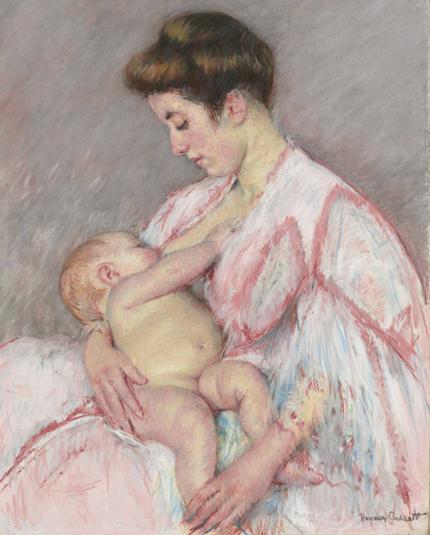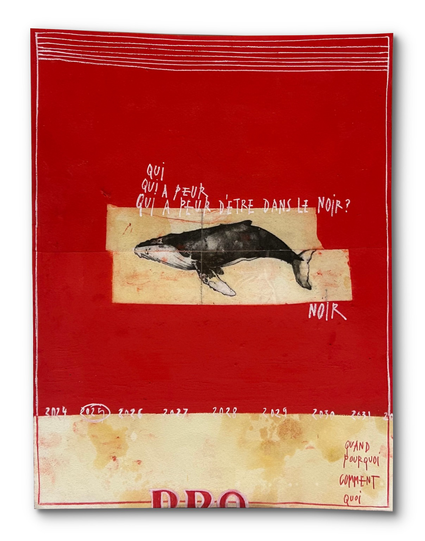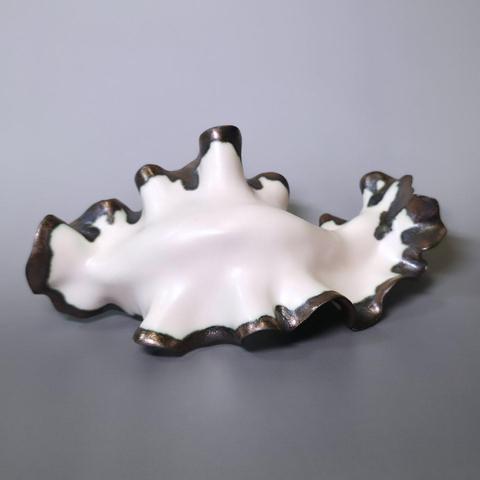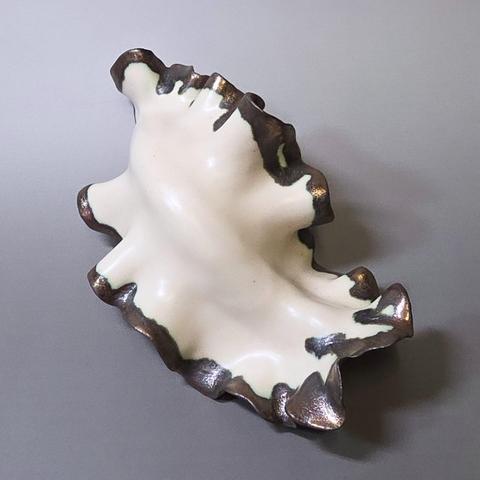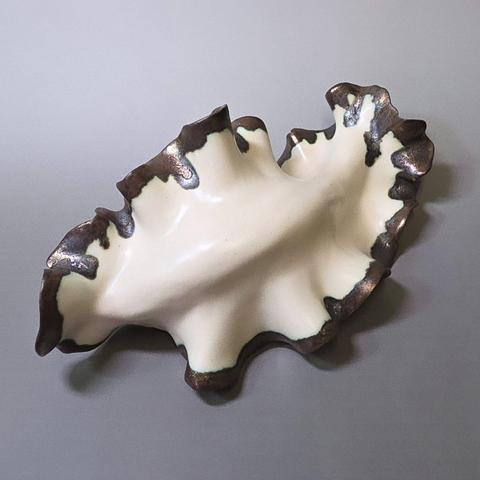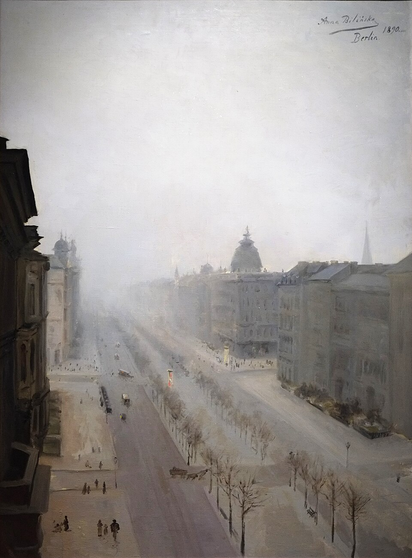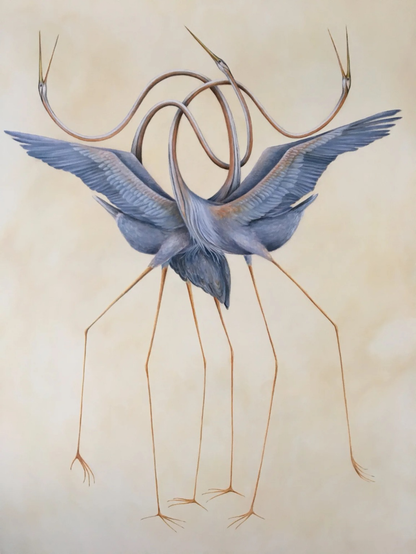#TilesOnTuesday :
Sibylle Peretti (German, active New Orleans, b. 1964)
Diluvial Land, 2025
Kiln-formed glass, engraved, silvered, painted, paper appliqué
On display at New Orleans Museum of Art (2024.59)
#BirdsInArt #ContemporaryArt #WomenArtists
#womenartists
"El Cid (Lion Head)," Rosa Bonheur, 1879.
Bonheur (1822-99) was an animaliere, or an artist who specialized in animals. Her portraits of wild and domestic animals, sometimes people's beloved pets, are remarkable for their realism but also lacking the sort of saccharine sentimentality that one might expect.
She would go to fairs and circuses in trousers (requiring a special "transvestite permit" to do so) and paint animals there; she even painted animals used in Buffalo Bill's Wild West Show when it played in Paris. She exhibited at the Chicago World's Fair and received the Legion of Honor in her native France, the first woman artist to be honored. A portrait of her, by Edouard Dubufe, has her with her arm around a bull...that she painted in herself.
Bonheur broke gender norms; she was an independent and successful artist, wore men's clothing, lived openly with other women, and enjoyed a freedom and power usually only reserved for men. She was known to view men as stupid and said the only men she had time for were the bulls she painted. Or this lion, who seems to express the wildness and determination that she felt in her own life.
Happy Portrait Monday! (And yes, animal portraits count.)
From the Museo del Prado, Madrid.
#Art #rosabonheur #WomenArtists #Lions #Animaliere #QueerHistory #QueerArtists #LGBTQIA
"Woman with Morning Glories," Katsushika Ōi, c. 1820s.
Katsushika (c. 1800 - c. 1866) was the daughter of the great Hokusai, by his second wife, but also an accomplished artist in her own right.
Not a lot about her life is known for sure, except she was her father's apprentice and assistant, and married another artist...but divorced him three years later. She moved back in with her father and never remarried, the two of them always busy with their art.
This print is intriguing; at first glance the woman seems to be simpering at the bowl of morning glories (on a tray that absurdly resembles a bathroom scale to modern eyes), but a closer look shows what may be a sheet of paper hidden behind the fan. Is she reading a clandestine letter? A poem from a lover? A naughty print? Who knows?
Sadly, not much of her art is known to survive to this day, but it is known that she was highly regarded in her lifetime. It's possible that some of her work is misattributed to others, including her father. But she remains the object of study and admiration.
Happy Flower Friday!
From the Los Angeles County Museum of Art.
#Art #KasushikaOi #JapaneseArt #AsianArt #ukiyo_e #MorningGlory #WomenArtists #WomenInArt #FlowerFriday
"Spanish Landscape with Mountains," Dora Carrington, c. 1924.
It may surprise you, but this seemingly innocuous landscape is considered a work of Surrealism.
Carrington (1893-1932) worked mostly as a designer and illustrator in her life, didn't exhibit, and really didn't become famous for her painting until after her death. She was a member of the Bloomsbury Group and was most famous for her unconventional but loving relationship with critic Lytton Strachey.
She loved traveling in Spain and was deeply impressed by the scenery there. Here he have orange hills with cacti, and some tiny travelers that seem a bit out of perspective. But it's the hills in the middle distance that attract attention; they're the color and texture of human skin and are very evocative of breasts. In her work she sometimes is noted as making the personal public, and she is doing so here.
In recent decades she has become recognized as a significant artist and has been the subject of multiple retrospectives, biographies, and the film "Carrington" where she was played by Emma Thompson.
From the Tate Gallery, London.
#Art #WomenArtists #Surrealism #Landscape #DoraCarrington #BloomsburyGroup
I realized recently that when I think of my art projects as "doodles" instead of Projects™️, the perceived stakes go down and mistakes are suddenly tolerable, acceptable even, and I can keep going enough to finish the "doodle"
Now I have a whole *portfolio* of "mistake-riddled doodles"
And also the unhinged audacity to think I can expand that into a mistake-riddled career
Anyway heres todays doodle-in-progress, details in alt 🌾
#womenartists #philippines #filipinoamerican #filipinoartists
Keep warm with your art history post for today: Crazy Quilt, ca. 1887–1900, Louisa Joiner (1844–1911), silk, ribbons, lace, velvet, embroidered, heat transfer; 186.7 x 182.9 cm (73 1/2 x 72 in.), The Cleveland Museum of Art. More info in ALT. #art #arthistory #fiberart #womanartist #womenartists #quilting
“And what is life? A crazy quilt;
Sorrow and joy, and grace and guilt,
With here and there a square of blue
For some old happiness we knew;
And so the hand of time will take
The fragments of our lives and make,
Out of life's remnants, as they fall,
A thing of beauty, after all.
— Douglas Malloch, “The Romance of the Patchwork Quilt in America.”
By Mary Cassatt (1844-1926), Baby John Nursing, ca. 1908, pastel on canvas, 32 x 25 ¾ in. (81.3 x 65.4 cm), photo: Christie’s New York, 19 Nov 2014. More information in ALT. #arthistory #womanartist #womenartists #art
From the lot essay: “Baby John Nursing, which captures the tenderness and mutual bond of a young woman and her infant, is exemplary of the confident yet sensitive manner in which Mary Cassatt executed her mature pastels. While Cassatt's work in the 1870s had reflected her interest in the experience of modern women in Parisian society, in the 1880s her emphasis began to shift from the public to the private domains of women's lives, and thus to the quiet, intimate moments spent within the domestic realm. Depictions of motherhood, largely comprised of simple, daily interactions between mothers and their children, were a natural outcome of Cassatt's movement into the private sphere, as these shared moments played a significant role in women's experience of modern life…
In pastels such as Baby John Nursing, Cassatt sought to capture, celebrate and elevate the intimate, hidden scenes of women's domestic life. Her sophisticated approach to the subject of motherhood was praised and distinguished her from her contemporaries. "She saw herself as a standard-bearer for the new freedom in art that had been won by the Impressionists, and was seen that way by others." (N.M. Mathews, Mary Cassatt, New York, 1994, p. 267) Cassatt's ability to convey the inimitable tenderness often present in a mother's interaction with her children while creating paintings that are simultaneously modern and traditional instills masterworks such as Baby John Nursing with a timeless appeal.”
Sans titre 2025 - Technique mixte sur papier / impression sur scotch - 32 x27 cm en deux parties . #art #artist #artwork #artsy #arts #womenartists #artcontemporary #artcontemporain #techniquemixte #impressions #scotch #michelemascherpa #peurdunoir #baleine
Every piece carries the memory of where it was born—this one holds Malibu’s salt air and the essence of nudibranchs and sea slugs.
"Malibu Waves"
Sea Dancer Series
White stoneware, glaze
2.5"Hx6"Wx3"D
DM for Purchase
Follow me to see which location I choose to create art in next...
#OceanInspiredArt #sylviealvarezart #ceramicsculpture #clayinnature #MalibuBeachVibes #homedecor #artforsale #artforinteriors #nudibranch #seaslug #womenartists #ArtCollectors
"Unter den Linden Street in Berlin," Anna Bilińska, 1890.
Bilińska (1854-93) was the first internationally noted woman artist from Poland, but only in the last few years has she gained any real recognition.
Born in present-day Ukraine, the daughter of a Polish physician, she often joked she had "a Cossack's temperament and a Polish heart." The family moved here and there in Russia before settling in Warsaw. There Anna learned piano, which was suitable for a woman of her class at the time, but she rebelled and took up painting, which in Warsaw society was seen as almost indecent.
She emigrated to Paris where she found artistic freedom and a chance to work and exhibit freely. She did mostly portraits, but also a few landscapes, like we have here. She married a Polish doctor and returned to Warsaw with the intention of opening a women's art school, but her life was cut short by a heart condition.
Her work was largely ignored in the 20th century, in part because of her sex, but also her short career. But in the 2010s her work was rediscovered and in 2021 the National Museum in Warsaw held a major retrospective. More scholarship on her is definitely in the works...
From the National Museum in Warsaw.
#Art #WomenArtists #AnnaBilinska #Berlin #Landscape #PolishArtists
Meryl Smith (NY, USA, b.1979)
#Herons, n.d.
Oil on canvas, 40” x 30“
http://merylsmith.com/herons
#BirdsInArt #ContrmporaryArt #WomenArtists
Well, I didn't know that. I wonder if they still have them?
One of the cool things is seeing so many women artists and illustrators! Probably so they could pay them less, you know, back then and all that, but still - professional women artists.
Read the Article: https://www.atlasobscura.com/articles/why-the-hallmark-card-company-owns-thousands-of-priceless-artworks
"...at the forefront of J.C. Hall’s rapidly growing greeting card business was a love of art."
#traditionalart #watercolor #gandalf #lordoftherings #artistsonpixelfed #womenartists #artstodon #painting
"The Bowl of Milk," Berthe Morisot, 1890.
Morisot (1841-95) was one of the founding female Impressionists, along with American Mary Cassatt. As is sadly frequent with female painters of the time, she was denied the same opportunities as the male painters but turned them to her advantage, by depicting scenes of everyday life and female subjects, but with a then avent-garde style.
The subject is young Gabrielle Dufour, a girl she knew in the village of Mézy, where Morisot and her family stayed for a while. She did a number of pictures of Dufour; sadly, nothing is known of the girl's life after this. One assumes she had the life of any other village girl.
Morisot was very close to Edouard Manet and married his brother, Eugene; her daughter Julie's diaries, published as "Growing Up with the Impressionists," give a behind-the-scenes look into the lives of these treasured painters.
Happy Portrait Monday!
From a private collection.
#Art #WomenArtists #BertheMorisot #WomenInArt #Impressionism
For #WorldNumbatDay :
Wendy Binks (Australia)
Wide World, 2015
Acrylic on canvas, 46 x 56 x 4cm
#ContemporaryArt #WomenArtists #Marsupials #Numbats
"Autumn Leaves," Mary Vaux Walcott, 1874.
Born into a wealthy Philadelphia Quaker family, Mary Vaux (1860-1940) took up watercolors in her youth, painting wildflowers during family trips to the Canadian Rockies. She also studied mineralogy and geology, studied the flow of glaciers, and became an active mountain climber, photographer, and all-around outdoorswoman while only in her 20s. She was the first woman to ascend Mount Stephen in British Columbia.
Beginning to focus on botanical illustration, she documented many plants of the Canadian Rockies. Late in life she married paleontologist Charles Walcott, then secretary of the Smithsonian, which in 1925 published a five-volume work of her illustrations.
She was a close friend of Lou Henry Hoover, was instrumental in the founding of DC's first Quaker meeting house, served as president of the Society of Women Geographers, and served on the US Board of Indian Commissioners from 1927 to 1935.
By the time of her passing she was hailed as the "Audubon of Botany" and a mountain in Alberta's Jasper National Park is named for her.
Not quite a flower, but still nice!
From the Smithsonian American Art Museum.
#Art #WomenArtists #MaryVauxWalcott #BotanicalIllustration #FlowerFriday
"Falling Leaves," Olga Wisinger-Florian, 1899.
Wisinger-Florian (1844-1926) was an Austrian-born member of the Stimmungsimpressionismus (or Mood Impressionist) movement of late 19th century Vienna. While something like this might be considered fairly standard work, at the time it was viewed as quite avant-garde.
After a career as a concert pianist ended due to a hand injury (seriously!), she learned painting under the noted Emil Schindler, and much of her work was in his style. But in 1884 she broke with him and adopted a stronger, more Expressionistic style which was very ahead of its time. She was quite renowned in her time, exhibiting at the Chicago World's Fair and fetching significant prices for her work.
Her work was largely landscapes and floral still lifes; today her body of work may seem conventional but it was different enough in her time to win her applause. And at least this work is very nice and seasonal.
From the Österreichische Galerie Belvedere, Vienna.
#Art #Impressionism #OlgaWisingerFlorian #WomenArtists #Autumn
For #NationalCatDay please admire this absolute masterpiece:
Gertrude Abercrombie (USA, 1909-1977)
#Black Cat on Pink, 1952
Oil on Hardboard, 4.5 x 4 cm (1 3/4 x 1 5/8 in.)
#CatsInArt #WomenArtists
#artstodon #artist #womenartists #artistsonpixelfed
By Leonora Carrington (1917-2011), The Temptation of St. Anthony, 1945, oil on canvas, 48 by 35 3/4 in. (122 by 91 cm), photo: Sotheby’s New York, 24 November 2014. #arthistory #womenartists #womanartist #painting #oilpainting
Excerpt from the catalogue note: ‘First recorded by Athanasius of Alexandria, the Temptation of St Anthony details the actions, teachings and many sufferings of Anthony the Great, an Egyptian, and one of the early Church Fathers. Inspired by a phrase in the Gospel of Matthew: "If you want to be perfect, go, sell what you have and give to the poor, and you will have treasures in heaven; and come, follow Me," the Tempation of St. Anthony became a popular legend in thirteenth-century Europe. Many of the more notable examples appear to deal with a passage in which Anthony, having recently left his parents and all of his worldly goods to pursue the life of a monk, descends into a cave where he is tempted by demons.’
